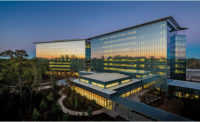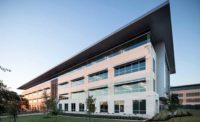Petroleum and transportation design firms continued to dominate the top 10 spots of ENR Texas & Louisiana’s annual list of Top Design firms. Companies were ranked according to self-reported regional revenue in 2015 and mirrored trends from last year.
|
Click Here to View the 2016 Top Design Firms Ranking |
However, despite continued sluggishness in the energy industry, top design firms report that work in other sectors is increasing, including transportation infrastructure, retail and residential as well as education and health care.
Only four of the top 20 firms on this year’s ranking reported an energy-related project as among their largest jobs to break ground last year, compared with eight such projects reported in the 2015 top 20. This year, six of the largest projects were transportation or mixed-use designs, compared with four from last year.
Meanwhile, revenue at the top 75 firms was only slightly behind 2014’s pace, with firms reporting collective regional revenue of $5.066 billion for 2015—slightly lower than 2014’s $5.1 billion for the top 75—but still well ahead of $4.1 billion in 2013 and $2.97 billion in 2012.
The top four firms on this year’s list were the same as last year, with Houston-based S&B Engineers and Constructors Ltd. ranked No. 1 with $681.6 million in regional revenue, and Houston-based Burns & McDonnell ranked second, posting $522.37 million.
AECOM and HDR rounded out the top four, with regional revenue of $231.32 million and $186.96 million, respectively. AECOM’s 2015 total declined by nearly $183 million from 2014. The top four firms earned a combined total of $1.09 billion during 2015, down from $1.60 billion in 2014.
Neil Graff, South Central regional director of operations for engineering at HDR, a transportation, general building and water supply design firm, notes that the firm’s drop of nearly $15 million in engineering revenue was due in part to the approaching completion of the IH 35E design-build project and changes in the broader regional economy. “So far this year, we have been impacted by the softness in the oil and gas market,” Graff says.
Meanwhile, HDR’s Dallas and Houston offices reported that 2015 revenue declined by $3.8 million from 2014, notes Heidi Higgason, the firm’s Southern region director of operations for architecture. One reason for the decrease is that several major projects moved into the construction phase during 2015, while they had been in design during 2014.
Houston-based Gensler earned the seventh spot on this year’s list, with $144.24 million in revenue for 2015, down $7 million from the prior year.
“The oil downturn in the last year has significantly affected the economic climate in the city of Houston and surrounding areas,” says David Calkins, Gensler regional managing principal. “Gensler is well diversified in its breadth of work with 31 different practice areas, such as health care, aviation and hospitality, which helps us navigate volatile economic changes that may arise.”
Calkins notes that while regional revenue did decline, the firm’s Dallas and Austin offices saw “a banner year” in 2015 and “are steadily expanding to accommodate the work we take on in those markets.”
Gensler landed several major projects in 2015, including The Star, a 91-acre, multi-use development in Frisco, Texas, that features the new world headquarters for the Dallas Cowboys and The Ford Center, a 12,000-seat, indoor multipurpose events center and sports training facility. Mid-Main is a transit-oriented development located along Houston’s heavily traveled light rail line. The mixed-use project is being developed through a public-private partnership.
Rising two spots to 10th on the list was Dallas-based Kimley-Horn, which posted $117.47 million in regional revenue for 2015, up $13 million from the previous year. Aaron Nathan, the firm’s Texas regional leader, says, “All of our growth is organic, not driven by mergers or acquisitions. Our client relationships, combined with an improving market, are driving significant growth in Texas.”
Working as advisers to various clients, Kimley-Horn has increased the number of projects the firm is working on for the Texas Dept. of Transportation, numerous municipalities and other public-sector clients as funding for infrastructure has increased, Nathan says.
“On the private-sector side, we have long-standing relationships with many residential, retail and industrial developers and owners,” he says. “These market sectors have become much more active, and we are working on an increasing number of new mixed-use projects, such as Legacy West in Plano and Cedar Port near Houston, residential projects like Trinity Falls and a large number of corporate relocations.”
Nathan also notes the continuing consolidation in the AEC industry, which “is driving senior professionals looking for a stable culture to Kimley-Horn. The turmoil in our industry has led many firms to sell or close their doors, while other firms binge on acquisitions,” he says.
Several of Kimley-Horn’s projects also sit along the “$5 Billion Mile” in Frisco, where $5.4 billion in investment has either been announced or is under construction in a one-mile stretch along the Dallas North Tollway. “Kimley-Horn has had a major role in the design of three of the four developments, which include The Star, Wade Park and Frisco station,” Nathan says. “We were also recently asked by the city of Frisco to help with the design of the associated Dallas North Tollway frontage roads fifth- and sixth-lane additions.”
Looking toward 2017, Judy Pesek, Gensler regional managing principal, says she expects to see regional growth in design and construction in “industries less affected by the price of oil and more focused on tourism, medical needs, community and repositioning.”
Pesek adds that by 2020, “more than half of the workplace will be made up by millennials. Our clients recognize this, and we continue to work with them to focus on different design solutions that think beyond 2020,” she says. “More so now than ever, it rings true that as designers, we must work toward improving people’s lives through the power of design.”











Post a comment to this article
Report Abusive Comment